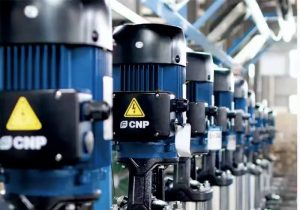Why do so many people choose to use permanent magnet motors now just because of their energy saving, which can reach about 20%? Today I will explain the influence of the geometry and tolerance of permanent magnet motor magnets on the width of motor magnets.
In a fixed magnetic circuit ring, when the thickness of the magnetic steel increases, it decreases the air gap between the rotor and the stator. For example, increasing the thickness by 1 mm would decrease the air gap by the same amount, and correspondingly increase the effective magnetic flux, since a stronger magnetic field can be maintained across the reduced air gap.
With an increased effective magnetic flux, the no-load speed of the motor tends to decrease. For example, if the thickness increases by 10%, the no-load speed can decrease by approximately 5-7%, depending on the motor design. Simultaneously, the no-load current decreases as the motor requires less power to overcome internal losses, potentially reducing by 3-5%. This improved magnetic coupling results in a more efficient motor operation under no-load conditions.
The greater thickness and higher magnetic flux can increase the peak efficiency of the motor by as much as 2-3%. The benefit, however, comes at some expense. Higher magnetic pull increases commutation vibrations that may require additional damping mechanisms. The efficiency curve for the motor becomes steeper: the motor operates optimally within a narrow range of speeds and loads. This can reduce the overall usefulness of the motor for those applications that require variable load.
In magnetic steel, there is a great need to ensure uniform thickness because, on the equal distribution of the magnetic field, mechanical imbalance causes vibration. For example, changes in thickness of about 0.1 mm result in increased vibration amplitude of about 2-3% which certainly hurts motor performance and its service life. Thus, uniform thickness helps in achieving smooth operations and enhances the life expectancy of the motor.

For brushless motors, the cumulative gap between magnets must be very tightly controlled. A total gap of more than 0.5 mm may not allow for proper installation and alignment. If the gap is too small, installation becomes problematic because of the tightness. Conversely, a gap too large can result in considerable vibrations and a loss in motor efficiency of up to 5-10%. This is because misalignment affects the effectiveness of rotor position detection by the Hall sensor, and as such, poor commutation efficiency with increased energy losses occurs.
The Hall elements utilized for establishing the position of the rotor rely on exact alignment with the magnets. A misalignment of only 0.2 mm can result in a timing error of several degrees, thus negatively impacting the efficiency and performance of the motor. Precise positioning ensures that the motor operates with smoothness and efficiency and minimizes the possibility of undue wear and tear.
In brush motors, there are intentional gaps between magnets to allow for mechanical commutation. These gaps are used as transition zones in which the brushes can change contacts without causing an arc or severe wear. Generally, a gap of around 0.3-0.5 mm is kept to balance efficient commutation with mechanical stability.
The rigorous installation process makes sure the magnets are correctly fitted within the motor assembly. Minor percentage errors in magnet width or positioning can result in major problems with performance. For instance, if a magnet is installed incorrectly, being off by as much as 0.2 mm, it will cause an offset of the rotor, with consequences such as added vibration and a loss of efficiency of 3-5%.
If it is too big, it may well result in poor installation, bringing mechanical stress to the motor and possible damage. If it is too small, the shift in operation may cause the misalignment of the magnet, increased vibration, and hence a huge drop in efficiency. Proper width ensures that magnets stay in the right place and operate efficiently.
Chamfering of the edges of the magnetic steel reduces the velocity of the change of a magnetic field in its edge area, which helps to minimize pulse vibrations. The chamfering to a radius of 0.5 mm can reduce the vibration amplitude by 2-4% and provide smoother running for the motor. Too little information about chamfering usually results in jumps in the magnetic field and increased pulsations and noise.
Chamfering is usually accompanied by a loss in magnetic flux. For example, a chamfer of size 0.8 mm can lead to about 0.5-1.5% loss of magnetic flux. This has to be considered against the benefit of a vibration reduction and thereby smoothness in operation.
Changing the chamfer size can balance residual magnetism and pulsation. For example, by slightly reducing the chamfer size, residual magnetism is increased by 1 to 2%, which would be useful for conditions where there is low residual magnetism, but this must be treated with caution since a steep rise might occur in the amplitude of pulsation.
The size of the chamfer directly affects the effective magnetic flux. While a larger chamfer reduces the flux slightly, it helps in smoother operation. A smaller chamfer retains more flux but may lead to increased vibrations. The optimal chamfer size, such as 0.5-0.7 mm, can maintain the trade-off between high efficiency and low vibration for optimal motor performance.
The no-load speeds and currents of DC motors are related to residual magnetism. For example, if one motor has higher residual magnetism, then the no-load speed may be reduced by 5-10% because of the higher value of magnetic flux. This in turn makes the no-load current lower, generally 10-15% lower than for motors with lower residual magnetism, since at this operating point the motor has less electrical resistance.
The higher the residual magnetism, the higher the maximum torque that a motor can achieve. Under particular conditions, if the residual magnetism is optimized, it is possible to achieve as much as a 20% increase in torque. The efficiency of the motor also improves; it is possible to have a 5-10% increase in efficiency at the peak efficiency points. These, however, need to be balanced with the possibility of increased vibration and noise.
No-load speed and maximum torque are the important indices reflecting motor performance. In such a test, for instance, a DC motor is said to be at its optimum operating speed of 3000 RPM with a maximum torque of 1.5 Nm. Deviations from this optimum will give an idea of variation in residual magnetism and the health of the motor. These tests generally involve the measurement of response under controlled load conditions and that the performance metrics fall within expected standards.

Coercivity affects both the magnet’s resistance to demagnetization and its operational stability at elevated temperatures. A magnet with high coercivity, for instance, 1000 kA/m, can withstand higher temperatures without losing its magnetic properties. This allows for a thinner magnet design, reducing the motor’s overall weight and size. Conversely, magnets with lower coercivity might require a thickness increase of 10-20% to maintain stability and prevent demagnetization, especially in high-temperature environments.
Operational needs and cost would decide the optimal coercivity values. In normal applications, for instance, 800-1000 kA/m would be adequate to keep stability and performance. Making the motor with excessively high coercivity will be very resource-intensive and is generally not needed, provided the operating temperature of the motor remains in the moderate range. Thus, coercivity values should match their specific application requirements to avoid excessively expensive material costs and utilize resources efficiently.
Flatness in the curve of motor efficiency is one key factor in performance assessment. A relatively flat efficiency curve means that, over a wide range of operating conditions, the performance is consistent. For example, a motor whose efficiency curve stays within 85-90% throughout its speed is desirable over another whose peak is at 92% but drops to 75% at other speeds. This consistency is crucial in applications needing reliable performance through variable loads and speeds.
In real-world applications, especially for hub motors in electric vehicles, the flatness of the efficiency curve directly affects performance. For example, in such varied road conditions as uphill or bad surfaces, the motor with a flatter efficiency curve will provide more reliable power and better energy use. For example, a hub motor that operates at 85% efficiency both on flat and inclined surfaces will provide better overall range and performance compared to one whose efficiency drastically drops on inclines. This translates to a smoother ride and more predictable power consumption, crucial for practical vehicle operation.
Its product line was made with a variety of designs in consideration of improving the performance of Permanent Magnet Motors based on the shape and tolerance of motor magnets.
Because of the great influence that makes a difference in the permanent magnet motor magnets that determines the general trend of its performance, it becomes important for ENNENG to provide needed expertise with specialized products.
The permanent magnet motors by ENNENG are well-designed, down to the very details in shape and tight tolerances. This will, in turn, increase the efficiency of the motors by less consumption of energy and more output power.
Employing only the latest manufacturing techniques coupled with excellent material ensures that the consistency in shape and dimensions of all motor magnets manufactured by ENNENG provides minimum variation in results. Precision in magnet shape and tolerance has a great relationship with smoother operation, low vibration, and high general reliability.
Besides, the product from ENNENG can be customized in magnet shape and tolerance according to customers’ detailed requirements. That would mean a wide latitude for customers to optimize their motor performance in their applications.
The ENNENG products ensure that the shape and tolerance of permanent magnet motors have very huge impacts on motor performance. The production of products at the company comes with definite shapes and tight tolerances that can allow for advanced efficiency, energy saving, and also increased reliability. One option, too, is to customize, enabling a customer to make modifications for the best fit to enhance motor performance.